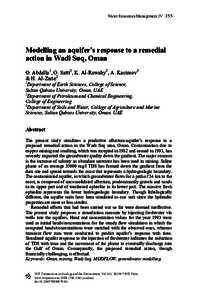Document
Modelling an aquifer's response to a remedial action in Wadi Suq, Oman.
Identifier
DOI: 10.2495/WRM070341
Source
WIT Transactions on Ecology and the Environment. v. 103, p. 355-363
Contributors
Country
United States.
City
Canada
Publisher
WITPress.
Gregorian
2007-01-01
Language
English
English abstract
The present study simulates a predictive alluvium-aquifers response to a proposed remedial action in the Wadi Suq area, Oman. Contamination due to copper mining and smelting, which was incepted in 1982 and ceased in 1993, has severely impacted the groundwater quality down the gradient. The major concern is the increase of salinity as abundant seawater has been used in mining. Saline plume of an average 35000 mg/l TDS has formed down the gradient from the dam site and spread towards the coast that represents a hydrogeologic boundary. The contaminated aquifer, in which groundwater flows for a path of 34 km to the coast, is composed of unconsolidated alluvium, predominantly gravels and sands in its upper part and of weathered ophiolite in its lower part. The massive fresh ophiolite represents the lower hydrogeologic boundary. Though lithologically different, the aquifer units have been simulated as one unit since the hydraulic properties are more or less similar. Remedial efforts that had been carried out so far were deemed ineffective. The present study proposes a remediation measure by injecting freshwater via wells into the aquifers. Head and concentration values for the year 1993 were used as initial heads/concentrations for the steady flow simulation in which the computed heads/concentrations were matched with the observed ones, whereas transient flow runs were conducted to predict aquifers response with time. Simulated aquifer response to the injection of freshwater indicates the reduction of TDS with time and the movement of the plume to eventually discharge into the Gulf of Oman.
ISSN
1743-3541
Category
Journal articles

